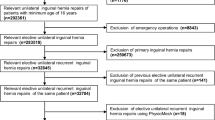Abstract
Purpose
If the pathogeneses of the development of a recurrence varies following the different methods of hernia repair, the time required to develop a recurrence could be expected to vary. The aim of the study was to identify risk factors affecting the time interval between the primary repair and the reoperation.
Methods
Data from the Swedish Hernia Register were used. Each year of the 5-year follow-up period was treated as a separate subgroup and merged together into one large group. For each risk factor, we performed a Cox proportional hazard analysis, testing for interactions between the year and the risk factor, with reoperation as the endpoint.
Results
Altogether, 142,578 repairs were recorded, of which 7.7% were performed on women. The mean age of the cohort was 59 years. The overall recurrence rate in the 5-year period was 4.3%. Multivariate analysis showed that recurrence following surgery for recurrent hernia occurred relatively early (P < 0.05).Recurrence also appeared early if postoperative complications were registered (P < 0.05). Recurrence after suture repair or laparoscopic repair appeared relatively early compared to recurrence following open mesh repair (P < 0.05). In a separate analysis, a relatively higher risk for early recurrence was seen for all sutured repairs compared to all mesh repairs (P < 0.05).
Conclusions
The pathogenesis behind the development of recurrence probably differs depending on the technique applied during the hernia repair. The higher proportion of early recurrences following laparoscopic repair, suture repair and recurrent repair may be explained by the high proportion of technical failures.
Similar content being viewed by others
References
van Veen RN, Wijsmuller AR, Vrijland WW, Hop WC, Lange JF, Jeekel J (2007) Long-term follow-up of a randomized clinical trial of non-mesh versus mesh repair of primary inguinal hernia. Br J Surg 94:506–510
Grant AM; EU Hernia Trialists Collaboration (2002) Open mesh versus non-mesh repair of groin hernia: meta-analysis of randomised trials based on individual patient data. Hernia 6:130–136
Bisgaard T, Bay-Nielsen M, Christensen IJ, Kehlet H (2007) Risk of recurrence 5 years or more after primary Lichtenstein mesh and sutured inguinal hernia repair. Br J Surg 94:1038–1040
Jansen PL, Mertens PR, Klinge U, Schumpelick V (2004) The biology of hernia formation. Surgery 136(1):1–4
Nordin P, Haapaniemi S, Kald A, Nilsson E (2003) Influence of suture material and surgical technique on risk of reoperation after non-mesh open hernia repair. Br J Surg 90:1004–1008
Nilsson H, Stylianidis G, Haapamäki M, Nilsson E, Nordin P (2007) Mortality after groin hernia surgery. Ann Surg 245(4):656–660
Campanelli G, Pettinari D, Nicolosi FM, Cavalli M, Avesani EC (2006) Inguinal hernia recurrence: classification and approach. Hernia 10:159–161
Kald A, Nilsson E, Anderberg B, Bragmark M, Engström P, Gunnarsson U, Haapaniemi S, Lindhagen J, Nilsson P, Sandblom G, Stubberöd A (1998) Reoperation as surrogate endpoint in hernia surgery. A three year follow-up of 1565 herniorrhaphies. Eur J Surg 164:45–50
Junge K, Rosch R, Klinge U, Schwab R, Peiper Ch, Binnebösel M, Schenten F, Schumpelick V (2006) Risk factors related to recurrence in inguinal hernia repair: a retrospective analysis. Hernia 10:309–315
Liem MSL, van Duyn EB, van der Graaf Y, van Vroonhoven TJMV; Coala Trial Group (2003) Recurrences after conventional anterior and laparoscopic inguinal hernia repair: a randomized comparison. Ann Surg 237(1):136–141
Arvidsson D, Berndsen FH, Larsson LG, Leijonmarck CE, Rimbäck G, Rudberg C, Smedberg S, Spangen L, Montgomery A (2005) Randomized clinical trial comparing 5-year recurrence rate after laparoscopic versus Shouldice repair of primary inguinal. Br J Surg 92:1085–1091
Nixon SJ, Jawaid H (2009) Recurrence after inguinal hernia repair at ten years by open darn, open mesh and TEP—no advantage with mesh. Surgeon 7(2):71–74
Swedish Hernia Register (2008) Home page at: http://www.svensktbrackregister.se. Accessed 1 Oct 2008
Klinge U, Krones CJ (2005) Can we be sure that the meshes do improve the recurrence rates? Hernia 9:1–2
Sevonius D, Gunnarsson U, Nordin P, Nilsson E, Sandblom G (2009) Repeated groin hernia recurrences. Ann Surg 249:516–518
Mikkelsen T, Bay-Nielsen M, Kehlet H (2002) Risk of femoral hernia after inguinal herniorrhaphy. Br J Surg 89:486–488
Junge K, Peiper C, Schachtrupp R, Rosch R, Kürten D, Klinge U, Schumpelick V (2003) Breaking strength and tissue elasticity after Shouldice repair. Hernia 7:17–20
Acknowledgments
This study was supported by the Centre for Clinical Research Dalarna, Sweden.
Author information
Authors and Affiliations
Corresponding author
Rights and permissions
About this article
Cite this article
Magnusson, N., Nordin, P., Hedberg, M. et al. The time profile of groin hernia recurrences. Hernia 14, 341–344 (2010). https://doi.org/10.1007/s10029-010-0648-1
Received:
Accepted:
Published:
Issue Date:
DOI: https://doi.org/10.1007/s10029-010-0648-1




